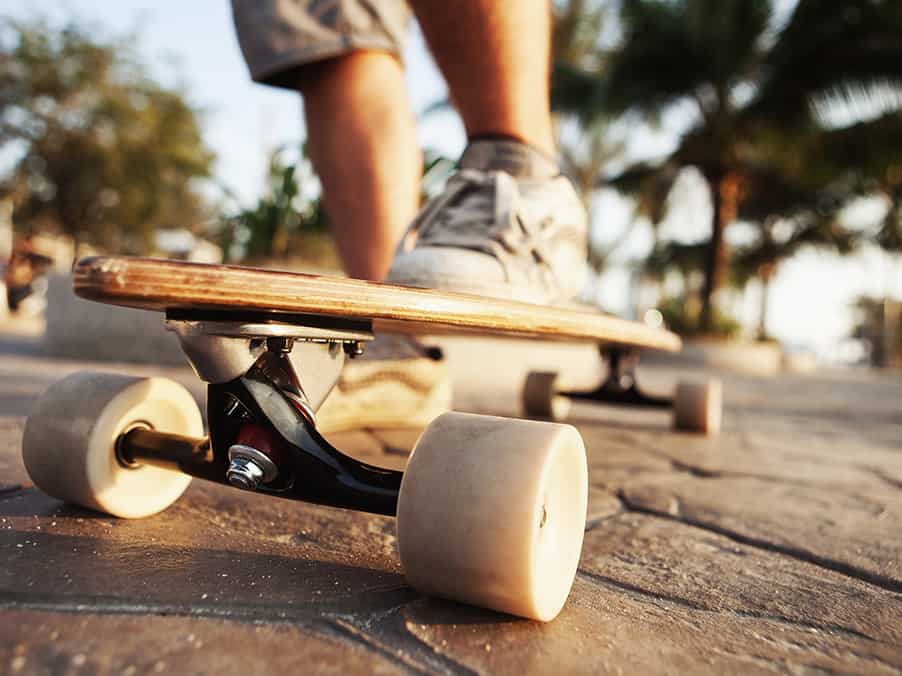
With a world looking to make their commutes more environmentally friendly, many people are looking for non-traditional ways of getting to and from work. You may have noticed more skateboards and longboards popping up around your city as they become a popular choice for commuters. But which is the better choice?
When it comes to commuting, longboards are the better choice. Skateboards are ideal for tricks and jumps at the skatepark, but that is often unnecessary when getting to and from work. Longboards offer a smooth and stable ride, even at high speeds, and are a good choice for beginners.
If you’re new to boards, you might not even be sure what the difference is between the two. The rest of this article will help explain both skateboards and longboards’ characteristics and why the longboard is the better choice for the daily commute.
Skateboard and Longboard: What’s the Difference?
While the general public tends to equate “skateboard” with any board they might see, it is important to know the difference between the two. Both have unique attributes that make them ideal for different settings and different riding styles.
Skateboards came onto the scene back in the 1950s. They were originally invented through surfers seeking a similar thrill on land. Longboards caught on in popularity later in the 1990s. Also developed out of love for surfing, they originally came about from putting soft wheels onto surfboards to more accurately catch the feeling of surfing on land.
To learn more about the difference between a skateboard and a longboard, watch this video:
Size
When we take a look at the size of the two boards, there are no surprises here, given the name “longboard.” Skateboards are smaller, with a typical length of about 28-32 inches. The edges of their deck, or top surface of the board, curl back in order to perform tricks, jumps, and sharp turns. However, their nimbleness in the skate park makes them less stable for beginners as they learn to get their balance.
Longboards come in a wide variety of shapes and sizes but are typically longer and wider than skateboards. They can be anywhere from 33-60 inches in length. The ample space on the flat deck gives the riders lots of space to place their feet. This allows beginners to feel comfortable and gain their balance quickly.
Wheels
Next up is the difference in the wheels. The wheels of the skateboard are smaller and harder than those of the longboard. These are the ideal type of wheels to grind and perform tricks, but they are easily impacted by uneven roads. It is easy for beginners to lose balance quickly when met with loose stones or other debris.
One of the longboard’s well-known characteristics is its large, soft wheels. This type of wheel gives you a smoother and quieter ride. You won’t hear or feel the bumps of rocks and cobblestones the way you would on a skateboard.
The wheelbase, which is the area from the center of the front wheels to the center of the back wheels, is naturally longer on a longboard. This does make it more difficult to make sharp turns compared to a skateboard. However, the need for tight turns should not be as necessary for a daily commute compared to the skate park.
Getting on Your Board
Beginners typically find it easier to get their balance and feel stable on a longboard more quickly than they would on a skateboard. This isn’t the only advantage to the longboard when it comes to riding. Another is the amount of energy it takes to keep the board going.
Pushing
With a skateboard, you get going and keep going by using your foot to push off from the ground. This is required throughout your ride to keep moving. This can be quite energy-consuming for the rider. However, this type of movement is not necessary on a longboard.
If you’ve seen longboards in action, you’ll notice the riders keep their feet on the board at all times. This is particularly necessary when moving at high speed. It would be quite hazardous to the rider if they needed to continuously make contact with the pavement below while moving so fast.
There are a few ways to build and maintain speed when riding a longboard. It’s possible to use your foot for a push to get started and then rely on gravity to keep going. However, to keep your speed up on flat stretches of land, you can utilize another method called “pumping.”
Pumping
There are various pumping styles, but in general, they involve distributing your weight in a cycle through your body, using your weight to create a wave of motion that translates to motion for your board. It requires a lot of subtle body movement and rhythm and is something that you can develop and refine over time.
As you perfect your pumping technique, you will be able to keep your longboard in motion with less energy than if you had to continuously push to keep moving. Once you have the motion down, you will be able to ride long distances at high speed just by moving your body weight on the board.
How to Choose Your First Longboard

If you are a beginner, you might feel overwhelmed because of all the longboard options out there. There are so many different riding styles for longboard enthusiasts, so naturally, there are many different types of longboards suited to each of these styles. For commuting, you can keep your eye out for “cruising” or “cruiser” longboards.
These types of boards won’t come well-equipped for tricks or more complicated riding styles, but they will provide comfortable and stable boards perfect for beginners and those looking to commute. They will typically have a flat deck and low center of gravity, perfect for beginning commuters.
One final tip for purchasing a longboard: get one from a skate shop. Skateboards and longboards are certainly available in big box stores. However, these are marketed more for kids and are generally considered to be closer to toys. To get a good-quality board that will give you the safest ride, it’s worth visiting your local skate shop or purchasing online from a recognized brand.
This video below will help you in choosing your first longboard:
Final Tips for Your Longboard Commute
Remember to stay safe out there as you’re making your environmentally friendly journey to work. Here are some tips to help you:
- Check your route. We know that the longboard has no problem smoothly gliding over rocks or loose debris on your path. However, still make sure your commute to work is paved. Longboards are meant to be ridden on pavement, not through grass or other natural material.
- Take precautions. Don’t forget your protective equipment! You can look into skateboarding helmets to protect your head in case of a topple off of your board. You may also consider some protection for your wrists and knees.
- Stay visible. For safety reasons, it is best if your commute is done during daylight. However, that may not always be possible. If it’s necessary to ride at night, put some thought into how you can be well lit out on the road. This may involve attaching lights to your helmet or board or wearing reflective clothing.
Last Mile Advantages
One last advantage is in regards to the “last mile commute.” A common problem, even in well-connected and developed cities worldwide, is the “last mile commute.” This refers to the last piece of your commute to get home, which may involve a long walk from your front door to the subway station or bus stop.
Watch this video to learn more about the “last mile commute”:
Perhaps your city offers quality public transportation, and there is no need to purchase a longboard for the majority of your commute. However, the portability of a longboard makes it a great choice for the last mile. Carrying a longboard after your ride is much easier than boarding a train with your bicycle, for example. This makes the longboard a great choice for those of us looking to speed up that last mile.
Final Thoughts
With the comfort of its large deck and its soft wheels that give you a smooth and quiet ride, longboards are becoming increasingly popular with commuters all over the country. Beginners can feel confident in purchasing their first longboard, knowing they will be riding well in a short time.
Skateboards are best suited for the skateparks, where their agility can be used for tricks and jumps. For these reasons, longboards are the ideal choice for your commute.


